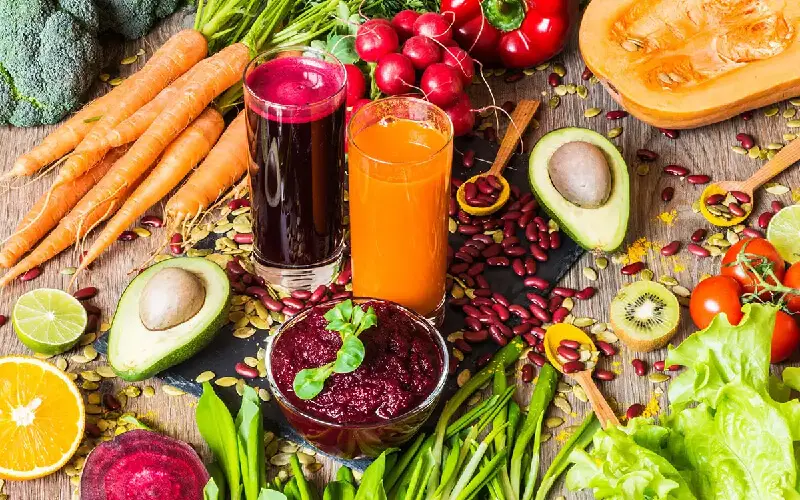
Raw Food
In recent years, the raw food movement has gained significant traction, with many people exploring the benefits of eating uncooked, unprocessed foods. This comprehensive guide will delve into the raw food diet, examining its health benefits, potential challenges, and how you can incorporate raw food into your lifestyle.
Click the text to discover the best tips for exercise, nutrition, and top-notch NIKE gear
Understanding Raw Food
What is Raw Food?
Raw food refers to foods that are uncooked and unprocessed, maintaining their natural enzymes and nutrients. This includes fruits, vegetables, nuts, seeds, and sprouted grains. The raw food diet advocates consuming these foods in their natural state or using minimal preparation methods, such as blending, juicing, or dehydrating, without exceeding temperatures of 104-118°F (40-48°C).
The Philosophy Behind Raw Food
The philosophy behind the raw food diet is rooted in the belief that heating food destroys its natural enzymes, which are crucial for digestion and nutrient absorption. Proponents argue that consuming food in its raw state enhances its nutritional value and supports overall health by maintaining the integrity of vitamins, minerals, and antioxidants.
Health Benefits of Raw Food
Enhanced Nutrient Intake
Raw foods are rich in vitamins, minerals, and antioxidants, which can support overall health and prevent chronic diseases. For example, raw fruits and vegetables are high in vitamin C, which boosts the immune system, and antioxidants like beta-carotene, which protect against cellular damage.
Improved Digestion
Consuming raw foods can improve digestion due to the presence of natural enzymes. These enzymes aid in breaking down food and absorbing nutrients more efficiently. Additionally, raw foods are often high in fiber, which promotes healthy bowel movements and prevents constipation.
Common Myths About Raw Food
Myth 1: Raw Food Lacks Protein
A common misconception is that a raw food diet is deficient in protein. However, many raw foods are excellent sources of plant-based protein. Nuts, seeds, sprouted grains, and certain vegetables, such as spinach and broccoli, provide substantial amounts of protein, supporting muscle maintenance and overall health.
Myth 2: Raw Food is Inherently Dangerous
Some believe that consuming raw food increases the risk of foodborne illnesses. While it’s true that raw food can harbor bacteria, proper handling and thorough washing can mitigate these risks. Additionally, many raw food enthusiasts adopt practices like fermenting and sprouting, which can enhance food safety and nutrient availability.
How to Start a Raw Food Diet
Transitioning Gradually
Transitioning to a raw food diet can be challenging, especially if you’re accustomed to cooked meals. Start by incorporating more raw fruits and vegetables into your diet gradually. Replace one meal a day with a raw alternative, such as a smoothie or a salad, and slowly increase the proportion of raw foods over time.
Stocking Your Kitchen
Having the right tools and ingredients is essential for a successful raw food diet. Equip your kitchen with a high-quality blender, a food processor, and a dehydrator. Stock up on fresh fruits, vegetables, nuts, seeds, and whole grains. Consider buying organic produce to avoid pesticide residues and enhance the nutritional quality of your food.
Delicious Raw Food Recipes
Raw Smoothie Bowls
Smoothie bowls are a delicious and nutritious way to start your day. Blend a mix of fruits, leafy greens, and plant-based milk, then top with nuts, seeds, and fresh fruit slices. Popular combinations include banana and spinach or berry and kale, both of which provide a refreshing and energizing breakfast.
Raw Salads and Dressings
Salads are a staple of the raw food diet, offering endless possibilities for creativity. Combine a variety of fresh vegetables, such as leafy greens, tomatoes, cucumbers, and bell peppers, with a homemade dressing. For a creamy dressing, blend avocado, lemon juice, and herbs, or make a tangy vinaigrette with olive oil, apple cider vinegar, and mustard.
Challenges of a Raw Food Diet
Nutritional Deficiencies
One potential challenge of a raw food diet is the risk of nutritional deficiencies. While raw foods are rich in certain nutrients, they may lack others, such as vitamin B12, iron, and omega-3 fatty acids. To address this, consider incorporating fortified foods or supplements into your diet to ensure you meet all your nutritional needs.
Social and Practical Considerations
Eating a raw food diet can sometimes be socially challenging, especially when dining out or attending social gatherings. To navigate these situations, plan ahead by bringing your own raw dishes to share or researching raw-friendly restaurants. Practicing flexibility and open communication with friends and family can also help make social interactions more enjoyable.
Raw Food and Weight Loss
Caloric Density and Satiety
Raw foods are typically low in calories but high in volume, which can help you feel full and satisfied while consuming fewer calories. This can support weight loss by creating a calorie deficit. Additionally, the high fiber content of raw foods promotes satiety, reducing the likelihood of overeating.
Metabolic Benefits
A raw food diet can boost metabolism and improve energy levels. The natural enzymes in raw foods support efficient digestion and nutrient absorption, which can enhance metabolic function. Moreover, the nutrient-dense nature of raw foods provides sustained energy throughout the day, reducing the need for frequent snacking.
The Environmental Impact of Raw Food
Sustainable Practices
A raw food diet can have positive environmental impacts by reducing reliance on processed and packaged foods. By consuming fresh, whole foods, you decrease the demand for industrial food production, which often involves significant resource use and environmental degradation. Growing your own produce or supporting local, organic farmers can further enhance sustainability.
Reduced Energy Consumption
Cooking food requires energy, whether through electricity, gas, or other means. By embracing a raw food diet, you minimize the energy needed for food preparation, contributing to a lower carbon footprint. Additionally, raw foods often require less packaging, further reducing waste and environmental impact.
Tips for Long-Term Success
Finding Balance
Maintaining a raw food diet over the long term requires finding balance and flexibility. It’s important to listen to your body and adjust your diet as needed. Incorporating some cooked foods, especially during colder months, can help maintain nutritional balance and prevent dietary fatigue.
Building a Support Network
Having a support network can be invaluable when transitioning to and maintaining a raw food diet. Connect with like-minded individuals through online communities, local meetups, or raw food workshops. Sharing experiences, recipes, and tips can provide motivation and inspiration on your raw food journey.
Raw Food and Mental Health
Mood and Energy Levels
The nutrients in raw foods can positively impact mental health by supporting brain function and mood regulation. High levels of antioxidants, vitamins, and minerals can reduce inflammation and oxidative stress, which are linked to mood disorders. Many people on a raw food diet report improved energy levels and mental clarity.
Stress Reduction
Preparing and consuming raw food can also be a mindful practice, promoting stress reduction and a deeper connection with your food. The act of selecting fresh produce, creatively preparing meals, and savoring natural flavors can be a form of self-care that enhances overall well-being.
Conclusion
Embracing a raw food diet offers numerous health benefits, from enhanced nutrient intake and improved digestion to weight loss and better mental health. While there are challenges, such as potential nutritional deficiencies and social considerations, these can be managed with careful planning and a balanced approach. By understanding the principles of raw food, incorporating delicious recipes, and building a supportive community, you can successfully transition to a raw food lifestyle and enjoy its transformative effects on your health and well-being.
Explore the benefits of a raw food diet and learn how to incorporate it into your lifestyle. Discover delicious recipes, health tips, and strategies for overcoming challenges in our comprehensive guide to raw food.
Rotation of Carbohydrates – A Long-Term Effective Dietary Regimen
The Ultimate Guide to Fasting: Benefits and Health Insights
Discover the latest fashion trends and beauty secrets! Click for a dose of inspiration!


